24 June 2020
A Stone Like No Other
An Interview with Joanna Hardy on the allure and mystique of emeralds.
Independent fine jewellery specialist and gemmologist Joanna Hardy discusses the unique beauty and enduring appeal of emeralds, and shares practical tips on buying and caring for them.
Joanna Hardy has over 30 years of experience working with jewellery. She began her career as a goldsmith, before training as a rough diamond valuer and grader. She then went to work in Antwerp, where she became one of the world’s very few female polished diamond dealers, also trading in Tel Aviv, Mumbai and New York. Joanna next moved into the world of London auction houses, first joining Phillips and then moving to Sotheby’s in Bond Street, where she spent 14 years as a senior jewellery specialist and auctioneer, with responsibility for jewellery auctions in New York, Geneva and London.
Now, as an independent fine jewellery specialist, Joanna conducts jewellery masterclasses and lectures worldwide. She is also a published author – her books, Collect Contemporary Jewelry, Emerald and Ruby, were published by Thames and Hudson – and a contributing author for Cartier Panthère, published by Assouline, and GRAFF, published by Rizzoli. Joanna writes for many international publications, curates contemporary jewellery exhibitions and recently launched her online jewellery school, learningwithexperts.com. She is an accredited Arts Society lecturer (formerly NADFAS), a Fellow of both the Gemmological Association and the Royal Society of Arts, a Freeman of the City of London, a Liveryman of Goldsmiths Hall and a regular jewellery specialist on the BBC’s Antiques Roadshow.
Why are emeralds special?
When you look at a rare, top gem-quality emerald, there is something about its unique colour that immediately draws you in. Its lustre and transparency have a calming effect, which is unique to emeralds, regardless of which deposit they came from. When viewing an emerald with a jeweller’s loupe, it is mind-blowing to think that the inclusions within the gemstone were formed millions of years ago – over 500 million years ago, if a Zambian emerald, and 50 million years, if Colombian – when the Earth’s plates were jostling for position, forming mountain ranges and continents, as we know them today. The inclusions, like fingerprints, are unique to every crystal, and therefore should be embraced for their ability to convey that moment in time to us, 500 million years later. The inclusions are telling us a story, but we still must listen hard, for they have captured a moment in time that we will never ever witness.
Emeralds represent rebirth, hope, paradise, luck and nature and that is why they have been the gemstone chosen to adorn Maharajahs, Kings and Queens from around the world, not to mention Hollywood glitterati. So, when you next see an emerald, take a moment to reflect on its journey, and if you are lucky enough to own one, remember that you will also become part of that emerald’s unique history. A gem-quality emerald is very rare, and therefore, very special.
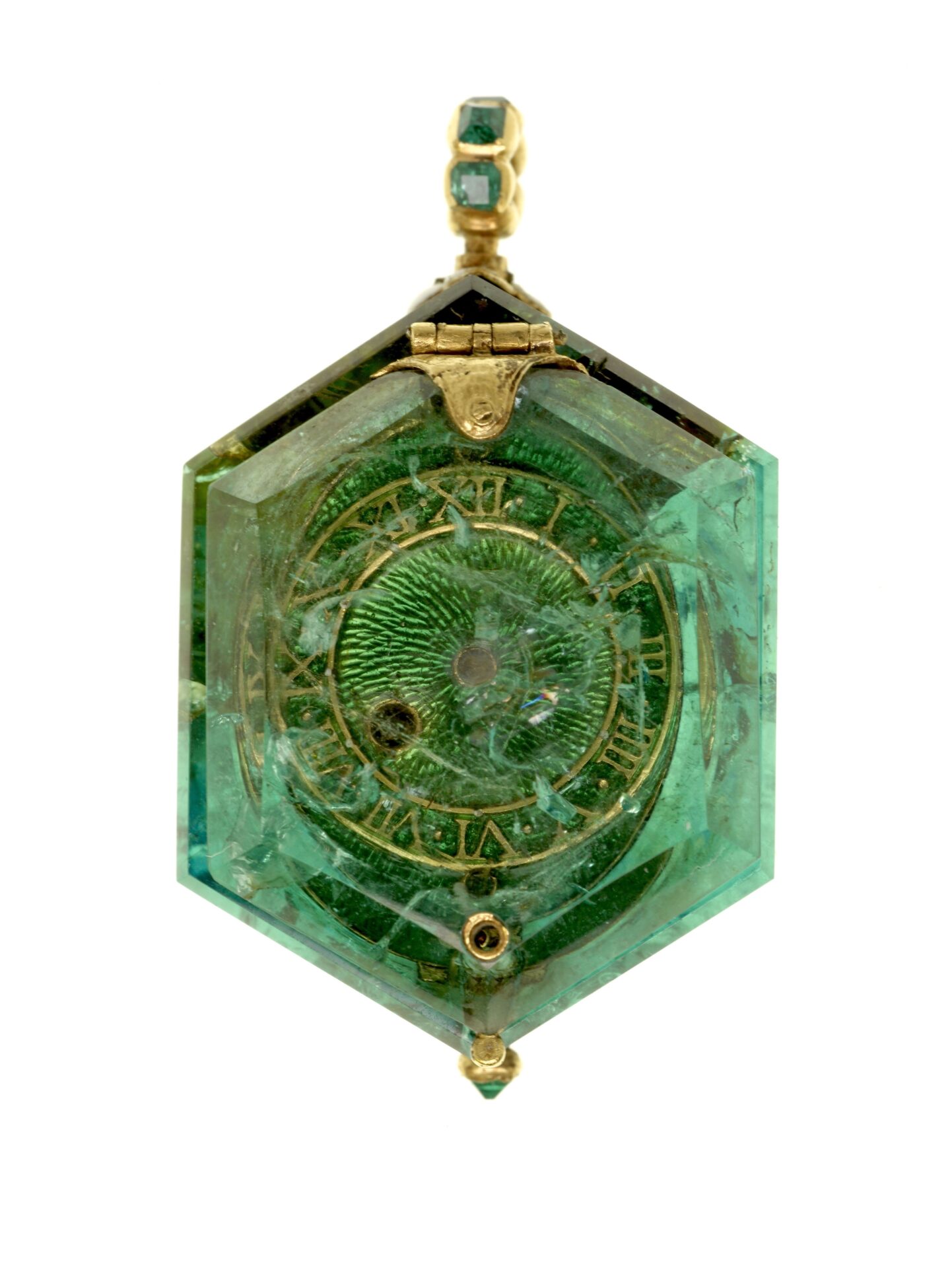
 What is my favourite piece of emerald jewellery?
It has got to be the emerald and diamond Art Deco necklace that once belonged to Hélène Beaumont. To get eleven beautifully graduated and perfectly matched emeralds is incredibly rare. The clarity of each emerald is so clear, and I love the cabochon sugarloaf cut – which perfectly emphasises how extraordinary these emeralds are, and how they beckon the eye to look deep within the stone. Set in a superbly crafted Art Deco necklace, it is an unforgettable, world-class piece of jewellery.
What is my favourite piece of emerald jewellery?
It has got to be the emerald and diamond Art Deco necklace that once belonged to Hélène Beaumont. To get eleven beautifully graduated and perfectly matched emeralds is incredibly rare. The clarity of each emerald is so clear, and I love the cabochon sugarloaf cut – which perfectly emphasises how extraordinary these emeralds are, and how they beckon the eye to look deep within the stone. Set in a superbly crafted Art Deco necklace, it is an unforgettable, world-class piece of jewellery.
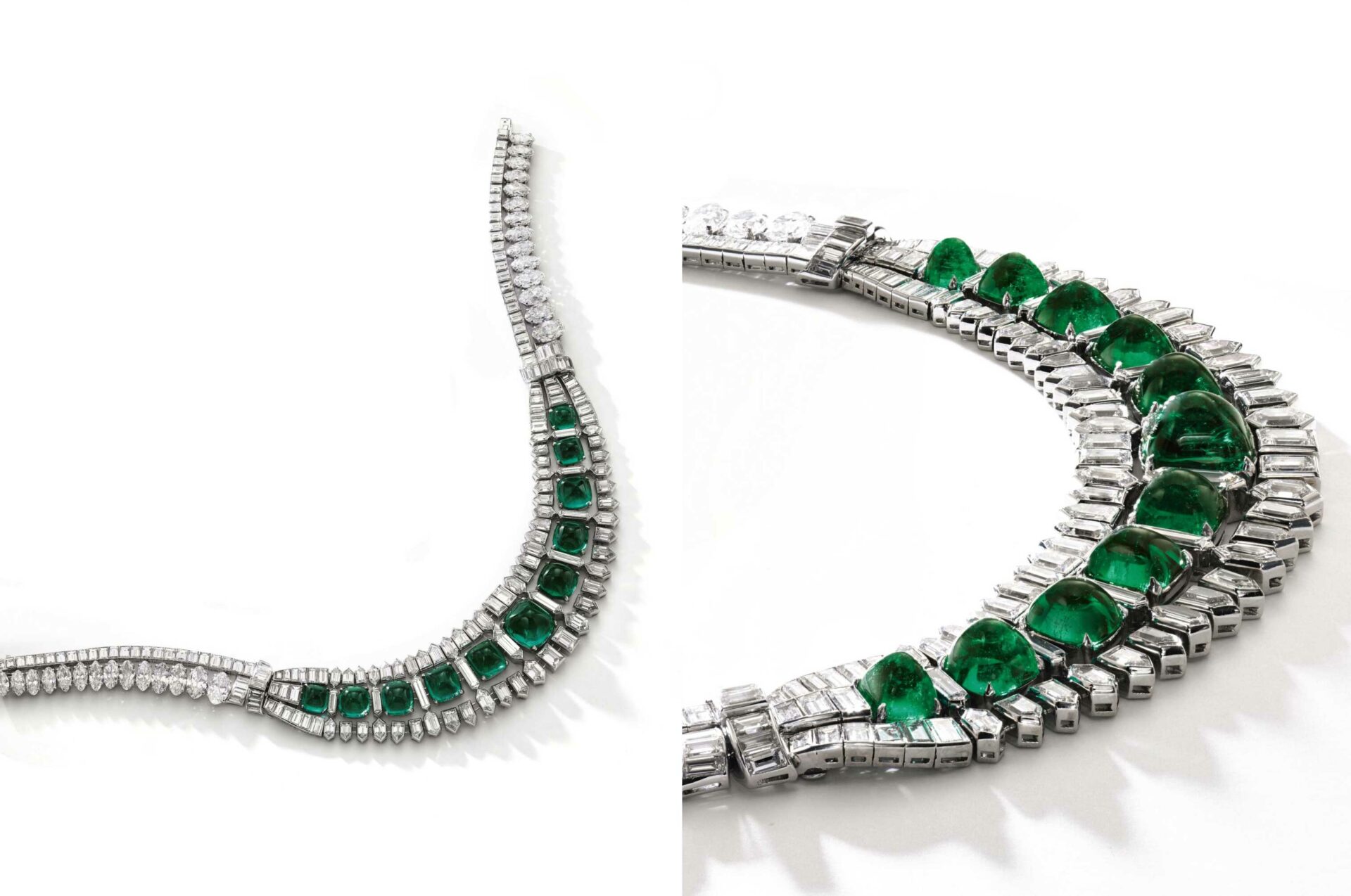 Photo Credit: Sotheby’s
What are some interesting and lesser-known facts about emeralds?
Emeralds were first known as smáragdos, which is derived from the Greek, meaning ‘green gem’; this terminology later led to the misidentification of other green stones as emeralds. In ancient times, it was believed that a snake was unlikely to bite anyone who was wearing an emerald. In 1609, Anselmus de Boodt, the Belgian mineralogist and physician, suggested that emeralds could cure dysentery, fever, panic and epilepsy and even stop bleeding.
The Romans felt that the soul of an individual was restored when they wore emeralds, and in early Egyptian and Greek lore, if anyone so much as dreamt of a green gem, he or she would become famous and meet with truth and fidelity. Mughal Emperors and Maharajahs loved emeralds so much that they used to inscribe the names of rulers or sacred texts from the Koran onto them, and the gems would then have to be worn touching the skin to give the words more potency.
Green was Napoleon Bonaparte’s favourite colour; he gave his stepdaughter an emerald and diamond parure, known as the Beauharnais Emeralds, as a wedding gift. Napoleon III made green the imperial colour, which caused further interest in emeralds during the period from 1852 to 1871.
Princess Mary, Jackie Kennedy and the Duchess of Windsor all wore emerald as engagement rings, causing a flurry of interest in emeralds, which are also the birthstone for the month of May and used to commemorate the 55th wedding anniversary. Lady Cunard (1872-1948), an American who married the founder of the Cunard shipping line and was renowned for her lavish London parties, loved emeralds so much that she changed her name to Emerald!
Photo Credit: Sotheby’s
What are some interesting and lesser-known facts about emeralds?
Emeralds were first known as smáragdos, which is derived from the Greek, meaning ‘green gem’; this terminology later led to the misidentification of other green stones as emeralds. In ancient times, it was believed that a snake was unlikely to bite anyone who was wearing an emerald. In 1609, Anselmus de Boodt, the Belgian mineralogist and physician, suggested that emeralds could cure dysentery, fever, panic and epilepsy and even stop bleeding.
The Romans felt that the soul of an individual was restored when they wore emeralds, and in early Egyptian and Greek lore, if anyone so much as dreamt of a green gem, he or she would become famous and meet with truth and fidelity. Mughal Emperors and Maharajahs loved emeralds so much that they used to inscribe the names of rulers or sacred texts from the Koran onto them, and the gems would then have to be worn touching the skin to give the words more potency.
Green was Napoleon Bonaparte’s favourite colour; he gave his stepdaughter an emerald and diamond parure, known as the Beauharnais Emeralds, as a wedding gift. Napoleon III made green the imperial colour, which caused further interest in emeralds during the period from 1852 to 1871.
Princess Mary, Jackie Kennedy and the Duchess of Windsor all wore emerald as engagement rings, causing a flurry of interest in emeralds, which are also the birthstone for the month of May and used to commemorate the 55th wedding anniversary. Lady Cunard (1872-1948), an American who married the founder of the Cunard shipping line and was renowned for her lavish London parties, loved emeralds so much that she changed her name to Emerald!
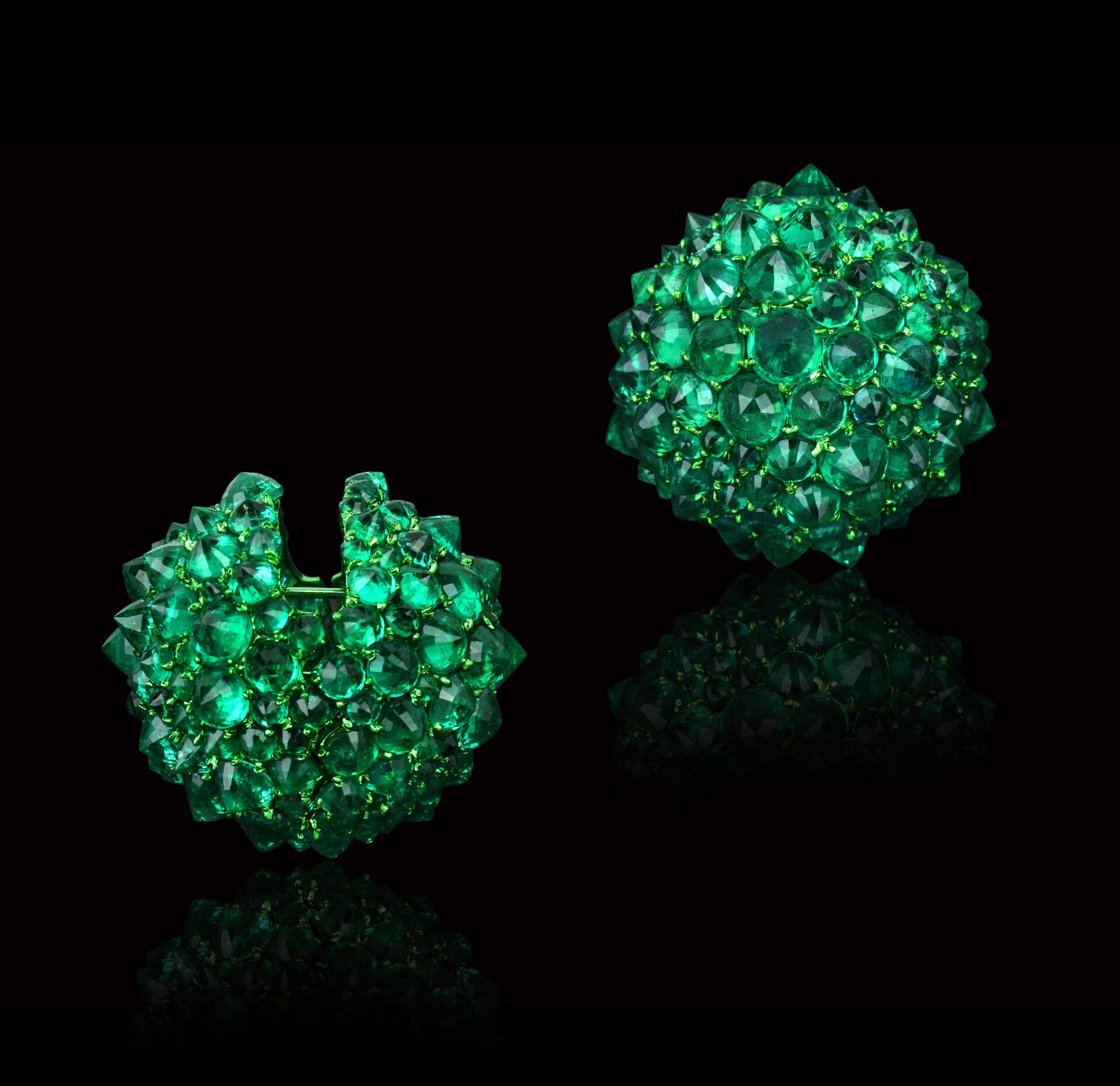
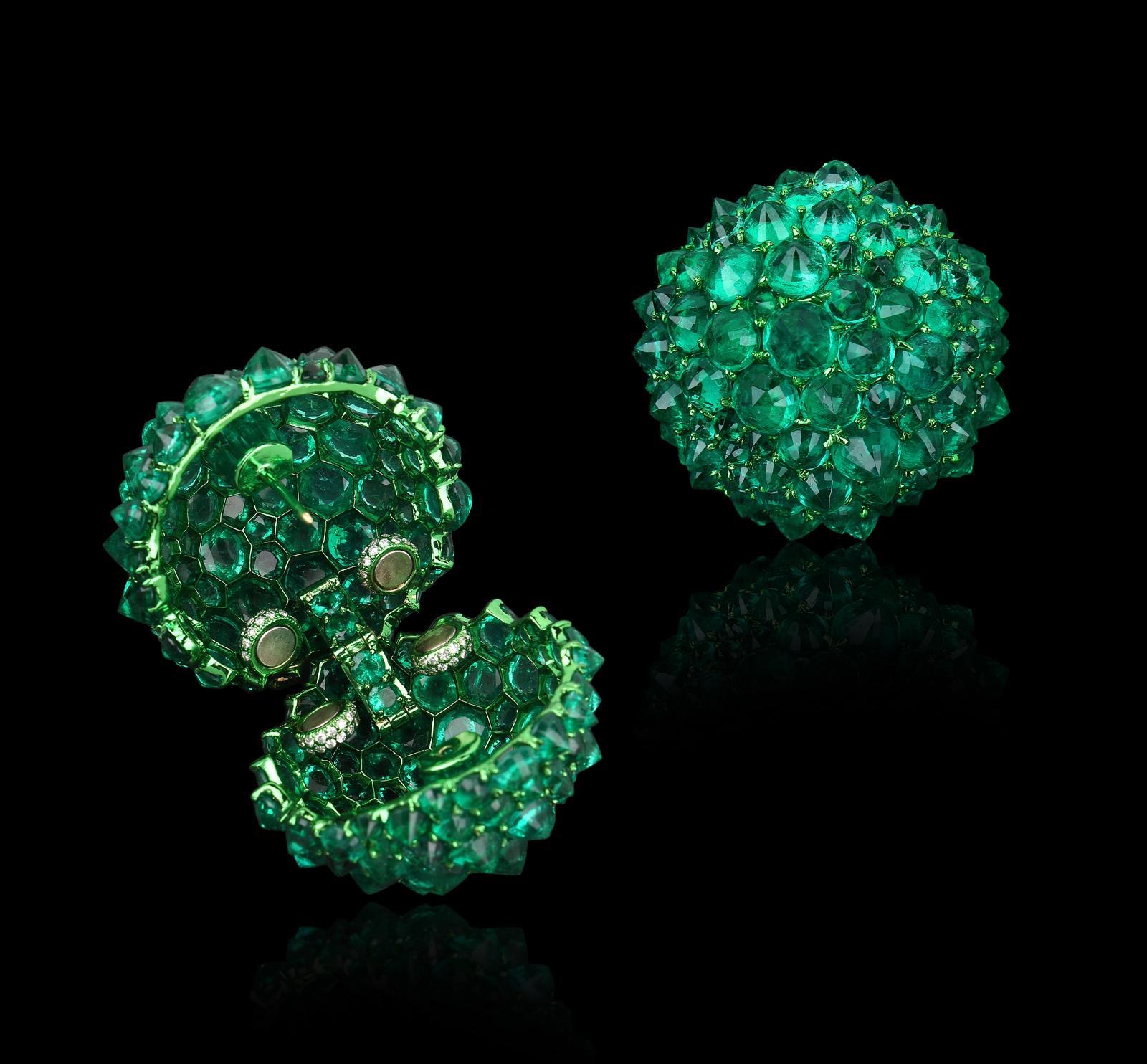 What should one look for when buying an emerald?
Colour
As with all coloured gemstones, you will first be drawn to a gem because of its colour – this is how the gemstone ‘speaks to you’ and is the first important factor to consider. They say that the gem chooses you before you choose the gem; whatever the case, you must feel connected to it in some way. Emeralds, like other gemstones, come in all different shades of green, and everyone will have their own colour preference. Whatever the colour, ideally you are looking for three elements that will make a difference to the appearance of the colour: hue – the basic body colour; each hue can have a secondary colour, for instance, bluish green or yellowish green hues; tone – whether the colour is light or dark; and saturation – whether there is an evenness and intensity of colour. If you like a pale green colour – which many people do – the price should be lower. The supply of deep green emeralds is more limited, hence their price is significantly higher.
Clarity
Some emeralds have formed with more natural inclusions than others. Inclusions are natural impurities made of a liquid, gas or a solid that were formed at a similar time to the crystal millions of years ago. We have been bombarded with the idea that diamonds need to have the minimum of inclusions, so that light entering the stone is not inhibited in any way to reduce the brilliance. Generally speaking, the fewer the inclusions, the higher the price. But with coloured gemstones the inclusions tell the story of the gem, as well as making it unique, for no two gemstones will ever be the same because of the varying orientations of the inclusions. You can be guaranteed that any gemstone you choose will be unique to you.
Ideally, you do want to choose a gem that has life, with a few inclusions. Emeralds, typically, have eye-visible inclusions which don’t affect their durability or beauty, but some flaws will block the passage of light, making the gem look dull and lifeless. These can be seen if you take a careful look at the gemstone with light reflected off the surface of its facets. You also don’t want inclusions reaching the surface of the gemstone from its interior, as this can weaken the structure and mean that, if knocked, it could chip or break.
It’s important that you take extra care with an emerald, because these gemstones can be brittle. Although hard, if you knock one in a vulnerable place, it could chip, cleave or fracture fairly easily.
Setting and Cuts
Ideally, the corners of the emerald need to be protected by claws. Be very careful if buying an emerald in a ‘rub-over mount’, which has metal wrapping around the edge of the stone, as there can be a danger that it could be a doublet: for instance, a gemstone made of two halves with a garnet top and an emerald bottom, or emerald top and emerald bottom with green cement in between. Doublets can give the appearance of improved colour, so you need to view the emerald side on. If you see an emerald that is in an enclosed gold mount, or there is only a small opening at the back of the setting, again, beware, as the gold can act as an enhancer and make the emerald a better colour than it really is.
The emerald cut, a rectangle with clipped corners, needs adequate depth, but not so much that the weight ends up being in the depth rather than in proportion to the width when viewed face up. The gemstone’s price will be calculated by multiplying the weight by the per-carat cost; consequently, if the gem is too deep, you will be paying for unnecessary, concealed weight. Choose a cut that is in proportion, symmetrical, and whose shape and outline are pleasing to the eye. The most common cut for an emerald is a step-cut, which has parallel stepped facets.
Buying
When buying any gemstone, light is very important, as colour will change according to the light source. It is always a good idea to make sure you can see the emerald in daylight and be aware that natural light may be slightly different in various parts of the world. If an emerald looks good out of direct light, this can be an indication that it is a good colour. Incandescent lighting enhances the colour of an emerald, making it look greener. Emeralds in candlelight look quite splendid, making them the ideal gem to be viewed in the evening. Always look at an emerald from all angles. All these factors must be considered when buying an emerald.
If you are buying a piece of jewellery which contains a significant emerald, you should always seek a gemmological report from one of the recognised laboratories, to ascertain if it has undergone any treatments to enhance its appearance. Emeralds have been oiled for centuries, which is acceptable, but modern enhancements and treatments need to be disclosed, as these greatly affect the value of the gemstone.
What should one look for when buying an emerald?
Colour
As with all coloured gemstones, you will first be drawn to a gem because of its colour – this is how the gemstone ‘speaks to you’ and is the first important factor to consider. They say that the gem chooses you before you choose the gem; whatever the case, you must feel connected to it in some way. Emeralds, like other gemstones, come in all different shades of green, and everyone will have their own colour preference. Whatever the colour, ideally you are looking for three elements that will make a difference to the appearance of the colour: hue – the basic body colour; each hue can have a secondary colour, for instance, bluish green or yellowish green hues; tone – whether the colour is light or dark; and saturation – whether there is an evenness and intensity of colour. If you like a pale green colour – which many people do – the price should be lower. The supply of deep green emeralds is more limited, hence their price is significantly higher.
Clarity
Some emeralds have formed with more natural inclusions than others. Inclusions are natural impurities made of a liquid, gas or a solid that were formed at a similar time to the crystal millions of years ago. We have been bombarded with the idea that diamonds need to have the minimum of inclusions, so that light entering the stone is not inhibited in any way to reduce the brilliance. Generally speaking, the fewer the inclusions, the higher the price. But with coloured gemstones the inclusions tell the story of the gem, as well as making it unique, for no two gemstones will ever be the same because of the varying orientations of the inclusions. You can be guaranteed that any gemstone you choose will be unique to you.
Ideally, you do want to choose a gem that has life, with a few inclusions. Emeralds, typically, have eye-visible inclusions which don’t affect their durability or beauty, but some flaws will block the passage of light, making the gem look dull and lifeless. These can be seen if you take a careful look at the gemstone with light reflected off the surface of its facets. You also don’t want inclusions reaching the surface of the gemstone from its interior, as this can weaken the structure and mean that, if knocked, it could chip or break.
It’s important that you take extra care with an emerald, because these gemstones can be brittle. Although hard, if you knock one in a vulnerable place, it could chip, cleave or fracture fairly easily.
Setting and Cuts
Ideally, the corners of the emerald need to be protected by claws. Be very careful if buying an emerald in a ‘rub-over mount’, which has metal wrapping around the edge of the stone, as there can be a danger that it could be a doublet: for instance, a gemstone made of two halves with a garnet top and an emerald bottom, or emerald top and emerald bottom with green cement in between. Doublets can give the appearance of improved colour, so you need to view the emerald side on. If you see an emerald that is in an enclosed gold mount, or there is only a small opening at the back of the setting, again, beware, as the gold can act as an enhancer and make the emerald a better colour than it really is.
The emerald cut, a rectangle with clipped corners, needs adequate depth, but not so much that the weight ends up being in the depth rather than in proportion to the width when viewed face up. The gemstone’s price will be calculated by multiplying the weight by the per-carat cost; consequently, if the gem is too deep, you will be paying for unnecessary, concealed weight. Choose a cut that is in proportion, symmetrical, and whose shape and outline are pleasing to the eye. The most common cut for an emerald is a step-cut, which has parallel stepped facets.
Buying
When buying any gemstone, light is very important, as colour will change according to the light source. It is always a good idea to make sure you can see the emerald in daylight and be aware that natural light may be slightly different in various parts of the world. If an emerald looks good out of direct light, this can be an indication that it is a good colour. Incandescent lighting enhances the colour of an emerald, making it look greener. Emeralds in candlelight look quite splendid, making them the ideal gem to be viewed in the evening. Always look at an emerald from all angles. All these factors must be considered when buying an emerald.
If you are buying a piece of jewellery which contains a significant emerald, you should always seek a gemmological report from one of the recognised laboratories, to ascertain if it has undergone any treatments to enhance its appearance. Emeralds have been oiled for centuries, which is acceptable, but modern enhancements and treatments need to be disclosed, as these greatly affect the value of the gemstone.

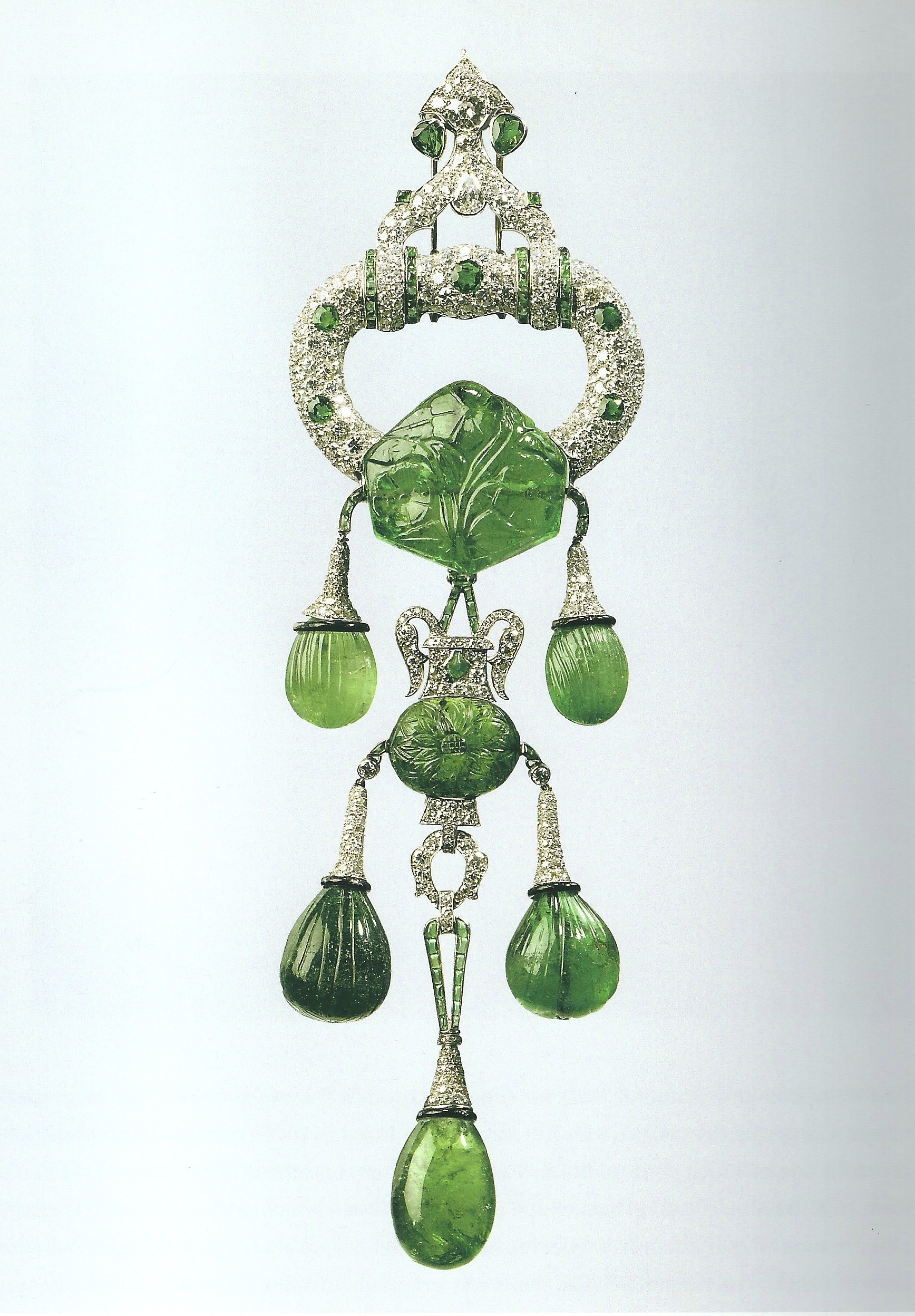 Caring for emeralds
Never try to clean emerald jewellery in an ultrasonic cleaner, because nearly all emeralds are soaked in oil during the cutting and storage process, and the cleaner may remove some oil enhancements, increase fractures, or even break the emerald. It is best to just use warm water with a mild detergent and a soft brush or take the piece to a jeweller to have it professionally cleaned.
Store your emerald jewellery in separate pouches to minimise scratches and damage from other gemstones.
At the end of the day, it is about going to a reputable jeweller and working with them to make sure you are buying a gem that you will want to cherish for many years to come.
Caring for emeralds
Never try to clean emerald jewellery in an ultrasonic cleaner, because nearly all emeralds are soaked in oil during the cutting and storage process, and the cleaner may remove some oil enhancements, increase fractures, or even break the emerald. It is best to just use warm water with a mild detergent and a soft brush or take the piece to a jeweller to have it professionally cleaned.
Store your emerald jewellery in separate pouches to minimise scratches and damage from other gemstones.
At the end of the day, it is about going to a reputable jeweller and working with them to make sure you are buying a gem that you will want to cherish for many years to come.
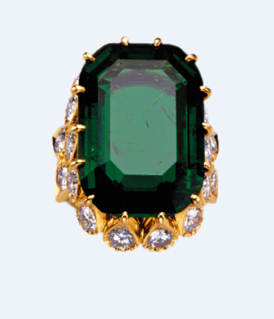


 What is my favourite piece of emerald jewellery?
It has got to be the emerald and diamond Art Deco necklace that once belonged to Hélène Beaumont. To get eleven beautifully graduated and perfectly matched emeralds is incredibly rare. The clarity of each emerald is so clear, and I love the cabochon sugarloaf cut – which perfectly emphasises how extraordinary these emeralds are, and how they beckon the eye to look deep within the stone. Set in a superbly crafted Art Deco necklace, it is an unforgettable, world-class piece of jewellery.
What is my favourite piece of emerald jewellery?
It has got to be the emerald and diamond Art Deco necklace that once belonged to Hélène Beaumont. To get eleven beautifully graduated and perfectly matched emeralds is incredibly rare. The clarity of each emerald is so clear, and I love the cabochon sugarloaf cut – which perfectly emphasises how extraordinary these emeralds are, and how they beckon the eye to look deep within the stone. Set in a superbly crafted Art Deco necklace, it is an unforgettable, world-class piece of jewellery.
 Photo Credit: Sotheby’s
What are some interesting and lesser-known facts about emeralds?
Emeralds were first known as smáragdos, which is derived from the Greek, meaning ‘green gem’; this terminology later led to the misidentification of other green stones as emeralds. In ancient times, it was believed that a snake was unlikely to bite anyone who was wearing an emerald. In 1609, Anselmus de Boodt, the Belgian mineralogist and physician, suggested that emeralds could cure dysentery, fever, panic and epilepsy and even stop bleeding.
The Romans felt that the soul of an individual was restored when they wore emeralds, and in early Egyptian and Greek lore, if anyone so much as dreamt of a green gem, he or she would become famous and meet with truth and fidelity. Mughal Emperors and Maharajahs loved emeralds so much that they used to inscribe the names of rulers or sacred texts from the Koran onto them, and the gems would then have to be worn touching the skin to give the words more potency.
Green was Napoleon Bonaparte’s favourite colour; he gave his stepdaughter an emerald and diamond parure, known as the Beauharnais Emeralds, as a wedding gift. Napoleon III made green the imperial colour, which caused further interest in emeralds during the period from 1852 to 1871.
Princess Mary, Jackie Kennedy and the Duchess of Windsor all wore emerald as engagement rings, causing a flurry of interest in emeralds, which are also the birthstone for the month of May and used to commemorate the 55th wedding anniversary. Lady Cunard (1872-1948), an American who married the founder of the Cunard shipping line and was renowned for her lavish London parties, loved emeralds so much that she changed her name to Emerald!
Photo Credit: Sotheby’s
What are some interesting and lesser-known facts about emeralds?
Emeralds were first known as smáragdos, which is derived from the Greek, meaning ‘green gem’; this terminology later led to the misidentification of other green stones as emeralds. In ancient times, it was believed that a snake was unlikely to bite anyone who was wearing an emerald. In 1609, Anselmus de Boodt, the Belgian mineralogist and physician, suggested that emeralds could cure dysentery, fever, panic and epilepsy and even stop bleeding.
The Romans felt that the soul of an individual was restored when they wore emeralds, and in early Egyptian and Greek lore, if anyone so much as dreamt of a green gem, he or she would become famous and meet with truth and fidelity. Mughal Emperors and Maharajahs loved emeralds so much that they used to inscribe the names of rulers or sacred texts from the Koran onto them, and the gems would then have to be worn touching the skin to give the words more potency.
Green was Napoleon Bonaparte’s favourite colour; he gave his stepdaughter an emerald and diamond parure, known as the Beauharnais Emeralds, as a wedding gift. Napoleon III made green the imperial colour, which caused further interest in emeralds during the period from 1852 to 1871.
Princess Mary, Jackie Kennedy and the Duchess of Windsor all wore emerald as engagement rings, causing a flurry of interest in emeralds, which are also the birthstone for the month of May and used to commemorate the 55th wedding anniversary. Lady Cunard (1872-1948), an American who married the founder of the Cunard shipping line and was renowned for her lavish London parties, loved emeralds so much that she changed her name to Emerald!

 What should one look for when buying an emerald?
Colour
As with all coloured gemstones, you will first be drawn to a gem because of its colour – this is how the gemstone ‘speaks to you’ and is the first important factor to consider. They say that the gem chooses you before you choose the gem; whatever the case, you must feel connected to it in some way. Emeralds, like other gemstones, come in all different shades of green, and everyone will have their own colour preference. Whatever the colour, ideally you are looking for three elements that will make a difference to the appearance of the colour: hue – the basic body colour; each hue can have a secondary colour, for instance, bluish green or yellowish green hues; tone – whether the colour is light or dark; and saturation – whether there is an evenness and intensity of colour. If you like a pale green colour – which many people do – the price should be lower. The supply of deep green emeralds is more limited, hence their price is significantly higher.
Clarity
Some emeralds have formed with more natural inclusions than others. Inclusions are natural impurities made of a liquid, gas or a solid that were formed at a similar time to the crystal millions of years ago. We have been bombarded with the idea that diamonds need to have the minimum of inclusions, so that light entering the stone is not inhibited in any way to reduce the brilliance. Generally speaking, the fewer the inclusions, the higher the price. But with coloured gemstones the inclusions tell the story of the gem, as well as making it unique, for no two gemstones will ever be the same because of the varying orientations of the inclusions. You can be guaranteed that any gemstone you choose will be unique to you.
Ideally, you do want to choose a gem that has life, with a few inclusions. Emeralds, typically, have eye-visible inclusions which don’t affect their durability or beauty, but some flaws will block the passage of light, making the gem look dull and lifeless. These can be seen if you take a careful look at the gemstone with light reflected off the surface of its facets. You also don’t want inclusions reaching the surface of the gemstone from its interior, as this can weaken the structure and mean that, if knocked, it could chip or break.
It’s important that you take extra care with an emerald, because these gemstones can be brittle. Although hard, if you knock one in a vulnerable place, it could chip, cleave or fracture fairly easily.
Setting and Cuts
Ideally, the corners of the emerald need to be protected by claws. Be very careful if buying an emerald in a ‘rub-over mount’, which has metal wrapping around the edge of the stone, as there can be a danger that it could be a doublet: for instance, a gemstone made of two halves with a garnet top and an emerald bottom, or emerald top and emerald bottom with green cement in between. Doublets can give the appearance of improved colour, so you need to view the emerald side on. If you see an emerald that is in an enclosed gold mount, or there is only a small opening at the back of the setting, again, beware, as the gold can act as an enhancer and make the emerald a better colour than it really is.
The emerald cut, a rectangle with clipped corners, needs adequate depth, but not so much that the weight ends up being in the depth rather than in proportion to the width when viewed face up. The gemstone’s price will be calculated by multiplying the weight by the per-carat cost; consequently, if the gem is too deep, you will be paying for unnecessary, concealed weight. Choose a cut that is in proportion, symmetrical, and whose shape and outline are pleasing to the eye. The most common cut for an emerald is a step-cut, which has parallel stepped facets.
Buying
When buying any gemstone, light is very important, as colour will change according to the light source. It is always a good idea to make sure you can see the emerald in daylight and be aware that natural light may be slightly different in various parts of the world. If an emerald looks good out of direct light, this can be an indication that it is a good colour. Incandescent lighting enhances the colour of an emerald, making it look greener. Emeralds in candlelight look quite splendid, making them the ideal gem to be viewed in the evening. Always look at an emerald from all angles. All these factors must be considered when buying an emerald.
If you are buying a piece of jewellery which contains a significant emerald, you should always seek a gemmological report from one of the recognised laboratories, to ascertain if it has undergone any treatments to enhance its appearance. Emeralds have been oiled for centuries, which is acceptable, but modern enhancements and treatments need to be disclosed, as these greatly affect the value of the gemstone.
What should one look for when buying an emerald?
Colour
As with all coloured gemstones, you will first be drawn to a gem because of its colour – this is how the gemstone ‘speaks to you’ and is the first important factor to consider. They say that the gem chooses you before you choose the gem; whatever the case, you must feel connected to it in some way. Emeralds, like other gemstones, come in all different shades of green, and everyone will have their own colour preference. Whatever the colour, ideally you are looking for three elements that will make a difference to the appearance of the colour: hue – the basic body colour; each hue can have a secondary colour, for instance, bluish green or yellowish green hues; tone – whether the colour is light or dark; and saturation – whether there is an evenness and intensity of colour. If you like a pale green colour – which many people do – the price should be lower. The supply of deep green emeralds is more limited, hence their price is significantly higher.
Clarity
Some emeralds have formed with more natural inclusions than others. Inclusions are natural impurities made of a liquid, gas or a solid that were formed at a similar time to the crystal millions of years ago. We have been bombarded with the idea that diamonds need to have the minimum of inclusions, so that light entering the stone is not inhibited in any way to reduce the brilliance. Generally speaking, the fewer the inclusions, the higher the price. But with coloured gemstones the inclusions tell the story of the gem, as well as making it unique, for no two gemstones will ever be the same because of the varying orientations of the inclusions. You can be guaranteed that any gemstone you choose will be unique to you.
Ideally, you do want to choose a gem that has life, with a few inclusions. Emeralds, typically, have eye-visible inclusions which don’t affect their durability or beauty, but some flaws will block the passage of light, making the gem look dull and lifeless. These can be seen if you take a careful look at the gemstone with light reflected off the surface of its facets. You also don’t want inclusions reaching the surface of the gemstone from its interior, as this can weaken the structure and mean that, if knocked, it could chip or break.
It’s important that you take extra care with an emerald, because these gemstones can be brittle. Although hard, if you knock one in a vulnerable place, it could chip, cleave or fracture fairly easily.
Setting and Cuts
Ideally, the corners of the emerald need to be protected by claws. Be very careful if buying an emerald in a ‘rub-over mount’, which has metal wrapping around the edge of the stone, as there can be a danger that it could be a doublet: for instance, a gemstone made of two halves with a garnet top and an emerald bottom, or emerald top and emerald bottom with green cement in between. Doublets can give the appearance of improved colour, so you need to view the emerald side on. If you see an emerald that is in an enclosed gold mount, or there is only a small opening at the back of the setting, again, beware, as the gold can act as an enhancer and make the emerald a better colour than it really is.
The emerald cut, a rectangle with clipped corners, needs adequate depth, but not so much that the weight ends up being in the depth rather than in proportion to the width when viewed face up. The gemstone’s price will be calculated by multiplying the weight by the per-carat cost; consequently, if the gem is too deep, you will be paying for unnecessary, concealed weight. Choose a cut that is in proportion, symmetrical, and whose shape and outline are pleasing to the eye. The most common cut for an emerald is a step-cut, which has parallel stepped facets.
Buying
When buying any gemstone, light is very important, as colour will change according to the light source. It is always a good idea to make sure you can see the emerald in daylight and be aware that natural light may be slightly different in various parts of the world. If an emerald looks good out of direct light, this can be an indication that it is a good colour. Incandescent lighting enhances the colour of an emerald, making it look greener. Emeralds in candlelight look quite splendid, making them the ideal gem to be viewed in the evening. Always look at an emerald from all angles. All these factors must be considered when buying an emerald.
If you are buying a piece of jewellery which contains a significant emerald, you should always seek a gemmological report from one of the recognised laboratories, to ascertain if it has undergone any treatments to enhance its appearance. Emeralds have been oiled for centuries, which is acceptable, but modern enhancements and treatments need to be disclosed, as these greatly affect the value of the gemstone.

 Caring for emeralds
Never try to clean emerald jewellery in an ultrasonic cleaner, because nearly all emeralds are soaked in oil during the cutting and storage process, and the cleaner may remove some oil enhancements, increase fractures, or even break the emerald. It is best to just use warm water with a mild detergent and a soft brush or take the piece to a jeweller to have it professionally cleaned.
Store your emerald jewellery in separate pouches to minimise scratches and damage from other gemstones.
At the end of the day, it is about going to a reputable jeweller and working with them to make sure you are buying a gem that you will want to cherish for many years to come.
Caring for emeralds
Never try to clean emerald jewellery in an ultrasonic cleaner, because nearly all emeralds are soaked in oil during the cutting and storage process, and the cleaner may remove some oil enhancements, increase fractures, or even break the emerald. It is best to just use warm water with a mild detergent and a soft brush or take the piece to a jeweller to have it professionally cleaned.
Store your emerald jewellery in separate pouches to minimise scratches and damage from other gemstones.
At the end of the day, it is about going to a reputable jeweller and working with them to make sure you are buying a gem that you will want to cherish for many years to come.

